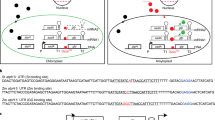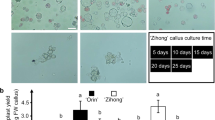Abstract
Over the past decade, several high value proteins have been produced in different transgenic plant tissues such as leaves, tubers, and seeds1,2. Despite recent advances, many heterologous proteins accumulate to low concentrations, and the optimization of expression cassettes to make in planta production and purification economically feasible remains critical. Here, the regulatory sequences of the seed storage protein gene arcelin 5-I (arc5-I) of common bean (Phaseolus vulgaris)3 were evaluated for producing heterologous proteins in dicotyledonous seeds. The murine single chain variable fragment (scFv) G4 (ref. 4) was chosen as model protein because of the current industrial interest in producing antibodies and derived fragments in crops5,6. In transgenic Arabidopsis thaliana seed stocks, the scFv under control of the 35S promoter of the cauliflower mosaic virus (CaMV) accumulated to approximately 1% of total soluble protein (TSP). However, a set of seed storage promoter constructs boosted the scFv accumulation to exceptionally high concentrations, reaching no less than 36.5% of TSP in homozygous seeds. Even at these high concentrations, the scFv proteins had antigen-binding activity and affinity similar to those produced in Escherichia coli. The feasibility of heterologous protein production under control of arc5-I regulatory sequences was also demonstrated in Phaseolus acutifolius, a promising crop for large scale production.
This is a preview of subscription content, access via your institution
Access options
Subscribe to this journal
Receive 12 print issues and online access
$209.00 per year
only $17.42 per issue
Buy this article
- Purchase on Springer Link
- Instant access to full article PDF
Prices may be subject to local taxes which are calculated during checkout


Similar content being viewed by others
References
Kusnadi, A.R., Nikolov, Z.L. & Howard, J.A. Production of recombinant proteins in transgenic plants: practical considerations. Biotechnol. Bioengin. 56, 473–484 (1997).
Fischer, R. & Emans, N. Molecular farming of pharmaceutical proteins. Transgenic Res. 9, 279–299 (2000).
Goossens, A., Dillen, W., De Clercq, J., Van Montagu, M. & Angenon, G. The arcelin-5 gene of Phaseolus vulgaris directs high seed-specific expression in transgenic Phaseolus acutifolius and Arabidopsis plants. Plant Physiol. 120, 1095–1104 (1999).
De Jaeger, G. et al. Use of phage display for isolation and characterization of single-chain variable fragments against dihydroflavonol 4-reductase from Petunia hybrida. FEBS LETT. 403, 116–122 (1997).
Zeitlin, L. et al. A humanized monoclonal antibody produced in transgenic plants for immunoprotection of the vagina against genital herpes. Nat. Biotechnol. 16, 1361–1364 (1998).
Potera, C. EPIcyte produces antibodies in plants. Genet. Eng. News (no. 4) 19, 22/40 (1999).
Phillips, J. et al. Seed-specific immunomodulation of abscisic acid activity induces a developmental switch. EMBO J. 16, 4489–4496 (1997).
Schouten, A. et al. The C-terminal KDEL sequence increases the expression level of a single chain antibody designed to be targeted to both the cytosol and the secretory pathway in transgenic tobacco. Plant Mol. Biol. 30, 781–793 (1996).
Krebbers, E. et al. Determination of the processing sites of an Arabidopsis 2S albumin and characterization of the complete gene family. Plant Physiol. 87, 859–866 (1988).
Goossens, A., Ardiles Diaz, W., De Keyser, A., Van Montagu, M. & Angenon, G. Nucleotide sequence of an arcelin 5-I genomic clone from wild Phaseolus vulgaris (accession no. Z50202). Plant Physiol. 109, 722 (1995).
Gallie, D.R. & Walbot, V. Identification of the motifs within the tobacco mosaic virus 5′-leader responsible for enhancing translation. Nucleic Acids Res. 20, 4631–4638 (1992).
Fiedler, U., Phillips, J., Artsaenko, O. & Conrad, U. Optimization of scFv antibody production in transgenic plants. Immunotechnology 3, 205–216 (1997).
De Jaeger, G. et al. High level accumulation of single-chain variable fragments in the cytosol of transgenic Petunia hybrida. Eur. J. Biochem. 259, 426–434 (1999).
van der Geest, A.H.M., Hall, G.E. Jr., Spiker, S. & Hall, T.C. The β-phaseolin gene is flanked by matrix attachment regions. Plant. J. 6, 413–423 (1994).
Hood, E.E., Kusnadi, A., Nikolov, Z. & Howard, J.A. Molecular farming of industrial proteins from transgenic maize. Adv. Exp. Med. Biol. 464, 127–147 (1999).
Stöger et al. Cereal crops as viable production and storage systems for pharmaceutical scFv antibodies. Plant Mol. Biol. 42, 583–590 (2000).
Saalbach, I., Giersberg, M. & Conrad, U. High-level expression of a single-chain Fv fragment (scFv) antibody in transgenic pea seeds. J. Plant Physiol. 158 529–533 (2001).
Clough, S.J. & Bent, A.F. Floral dip: a simplified method for Agrobacterium-mediated transformation of Arabidopsis thaliana. Plant J. 16, 735–743 (1998).
Dillen, W., De Clercq, J., Goossens, A., Van Montagu, M. & Angenon, G. Agrobacterium-mediated transformation of Phaseolus acutifolius A. Gray. Theor. Appl. Genet. 94, 151–158 (1997).
Friguet, B., Chaffotte, A.F., Djavadi-Ohaniance, L. & Goldberg, M.E. Measurements of the true affinity constant in solution of antigen-antibody complexes by enzyme-linked immunosorbent assay. J. Immunol. Methods 77, 305–319 (1985).
Acknowledgements
We thank T. Hall (Texas A&M University) for providing the β-phaseolin promoter; Dominique Eeckhout, Peter Casteels, Bart Hoorelbeke, Ingrid Peck, Annelies De Clercq, Romain Uytterhaegen, Wilson Ardiles, Rebecca Verbanck, Lien Van Speybroeck, and Martine De Cock for advice and assistance; and the Vlaams Instituut voor de Bevordering van het Wetenschappelijk-Technologisch Onderzoek in de Industrie for financial support.
Author information
Authors and Affiliations
Corresponding author
Ethics declarations
Competing interests
The authors declare no competing financial interests.
Rights and permissions
About this article
Cite this article
Jaeger, G., Scheffer, S., Jacobs, A. et al. Boosting heterologous protein production in transgenic dicotyledonous seeds using Phaseolus vulgaris regulatory sequences. Nat Biotechnol 20, 1265–1268 (2002). https://doi.org/10.1038/nbt755
Received:
Accepted:
Published:
Issue Date:
DOI: https://doi.org/10.1038/nbt755
This article is cited by
-
Fusing the 3’UTR of seed storage protein genes leads to massive recombinant protein accumulation in seeds
Scientific Reports (2023)
-
Plant Platforms for Efficient Heterologous Protein Production
Biotechnology and Bioprocess Engineering (2021)
-
Expression of Single Chain Variable Fragment (scFv) Molecules in Plants: A Comprehensive Update
Molecular Biotechnology (2020)
-
Transgenic Nicotiana tabacum seeds expressing the Mycobacterium tuberculosis Alanine- and Proline-rich antigen
AMB Express (2018)



